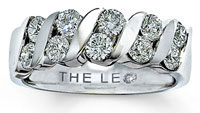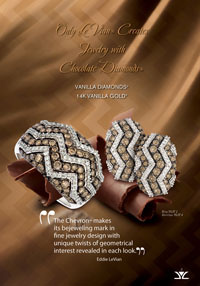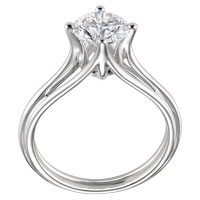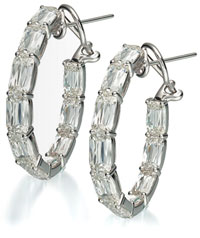Is that brand-name diamond a cut above the others?
 In the cereal aisle or in the auto showroom you may recognize brand names and know what they mean. But how about when you see a brand-name diamond on a jewelry appraisal? Since diamond is actually made in the earth, what does brand mean here?
In the cereal aisle or in the auto showroom you may recognize brand names and know what they mean. But how about when you see a brand-name diamond on a jewelry appraisal? Since diamond is actually made in the earth, what does brand mean here?
And: how much does the diamond's brand matter to the underwriter or adjuster?
We're conditioned to associate brand names with high quality—somebody must have put a lot of time and money into developing this new thing to make it really good. We'd do better to associate brand with high price—somebody has spent a lot of money on an advertising campaign, and that expenditure has to be recovered.
Branding diamonds is a fairly new phenomenon, dating from 1985 with the Lazare Kaplan diamond. The practice got a big boost during the wobbly economy, as suppliers and retailers looked for a way to stand out, to get a marketing edge. The trend has really taken off since then, and today there are well over a hundred brand names for diamonds. Even comparatively small jewelry retailers may come up with their own diamond brand.
Is it a cut above?
Brand names of diamonds are often names for the cut of the diamond. It may be a distinctive new shape or a minor modification of a traditional shape. Often the change is adding more facets,  which the company's advertising says will "optimize the diamond's light performance," "improve light return," "create the most light dispersion possible," "enhance fire and brilliance," etc. It's worth noting that none of these claims has been verified by the industry's leading independent laboratories.
which the company's advertising says will "optimize the diamond's light performance," "improve light return," "create the most light dispersion possible," "enhance fire and brilliance," etc. It's worth noting that none of these claims has been verified by the industry's leading independent laboratories.
Any name will draw extra attention, but some names are more forceful than others. Hearts on Fire: the World's Most Perfectly Cut Diamond®, for example, is a grabber. Some branded cuts are patented and proprietary, others are not.
Names and mottos are all part of the sales strategy. Names and even taglines may be registered trademarks. One extreme example is a company that has trademarked the name chocolate diamond—a common phrase used in the jewelry industry for brown diamonds. It's a clever marketing move, because brown diamonds are actually extremely common and inexpensive. In fact, they've been considered poor quality, off-color diamonds. The trademarked name and a clever ad campaign aim to make them desirable. The company has also trademarked vanilla and strawberry diamonds, and a number of other phrases used in their advertising. It's all part of the name game.
Producers further count on luring consumers through presentation and packaging. Branded diamonds are often laser-inscribed with the brand name and a registration number, playing on the idea that the diamond is unique. Some retailers even include with each sale a lens with which to view these inscriptions. The package for a branded diamond usually includes a diamond report—sometimes from a well-known independent lab, sometimes with the brand name highlighted at the top.
Important for insurers to know:
Branded does not mean patented.
A patented cut diamond, such as Tiffany's Lucida, should be named on the appraisal. If a patented cut stone is lost—and the patent is still in effect—the cut cannot be legally duplicated by others. The insurer would have to locate another patented stone in the secondary market or go to the patent holder for a replacement.
On the appraisal, a patented stone is appropriately valued at its selling price. The original price may have been high, but the consumer was willing to pay it. However, patented cuts do not necessarily hold their value just because they are name brands. The Lucida, despite its high breeding, fell in popularity and so it fell in market value. In a few years, it could be found at auctions and other secondary markets for a much lower price, so it's value on an appraisal should reflect that lowered value.
If the patent has expired, the insurer could buy or have cut a diamond of the same proportions from another source (at considerably lower cost). New technologies can analyze a stone to the finest details, measuring light return, showing inclusions, etc., as well as showing precise faceting geometry. Another stone could easily be cut to the same proportions as Lucida.
A "branded diamond," on the other hand, just means a manufacturer has given a name to a generic diamond of a specific cut, i.e., round brilliant Ideal cut.
It's a merchandising move, because a clever name attracts customers and because people tend to associate brand names with high quality. But it's just a name.
Hearts on Fire diamonds, for example, draw premium prices because the name currently has cachet. But a Hearts on Fire diamond doesn't have to be replaced by a Hearts on Fire diamond—it can be replaced by a comparable diamond with all the same characteristics as the stone in question. With jewelry, as with automobiles, the insurer's obligation is to replace with like kind and quality.
Case Study for Insurers
Suppose a client comes to you for insurance on an engagement ring he's just purchased. He has the seller's appraisal, sales receipt and a GIA report. The sales receipt says he paid $70,000, and it shows the name Cartier (or Tiffany, or some other Big Name). The seller's appraisal values it at $70,000.
Another client comes to you for coverage of an engagement ring purchased from Costco. The appraisal and GIA report show this ring has exactly the same qualities as the Cartier ring, except for the trademark. But the Costco sales receipt shows a price of $40,000, and comes with an IGI appraisal valuation for $70,000.
Is the Cartier ring really "worth" $30,000 more?
If it were lost, would you have to replace it with a ring from Cartier?
The generic mounting can be duplicated for perhaps $3,000. Cartier and Tiffany are not making these generic pieces in their own workshops. They job out for mounts or semi-mounts, probably to the same manufacturers that supply other independent guild stores, and then add the diamond(s).
Most of the ring's value comes from the diamond. This is not a "Cartier diamond" or a "Tiffany diamond." It is not a patented cut. It's a typical diamond. As we know from our example, this ring could be bought at competitive retail (Costco) for $40,000. If the insurer used a cost basis for replacement (raw material of the metal + fabrication cost + cost of stone + a reasonable markup for the merchant) the cost could be even less.
That lowest replacement cost is what the insurer's settlement should be. Insurers are legally obligated to put the insured in a pre-loss condition at the lowest cost to the insurer at time of loss. Anything more than that disregards the "public policy and indemnification" insurance legal cannon.
Those who argue that the prestige name adds to the value of the jewelry are often times mistaken. Once the purchase is made, value declines. One insurer who tracks jewelry's secondary markets found a substantially identical Cartier ring that sold at auction for $28,000.
What about that $30,000?
The $30,000 difference between the (Tiffany, Cartier, etc.) ring and the Costco ring turns out to be the price of the shopping experience—luxury store, blue box with a white bow. Once the purchase is made, the value attached to the shopping experience is lost. This sentimental value is neither tangible nor measurable, and it's not insurable.
Another client comes to you for coverage of an engagement ring purchased from Costco. The appraisal and GIA report show this ring has exactly the same qualities as the Cartier ring, except for the trademark. But the Costco sales receipt shows a price of $40,000, and comes with an IGI appraisal valuation for $70,000.
Is the Cartier ring really "worth" $30,000 more?
If it were lost, would you have to replace it with a ring from Cartier?
The generic mounting can be duplicated for perhaps $3,000. Cartier and Tiffany are not making these generic pieces in their own workshops. They job out for mounts or semi-mounts, probably to the same manufacturers that supply other independent guild stores, and then add the diamond(s).
Most of the ring's value comes from the diamond. This is not a "Cartier diamond" or a "Tiffany diamond." It is not a patented cut. It's a typical diamond. As we know from our example, this ring could be bought at competitive retail (Costco) for $40,000. If the insurer used a cost basis for replacement (raw material of the metal + fabrication cost + cost of stone + a reasonable markup for the merchant) the cost could be even less.
That lowest replacement cost is what the insurer's settlement should be. Insurers are legally obligated to put the insured in a pre-loss condition at the lowest cost to the insurer at time of loss. Anything more than that disregards the "public policy and indemnification" insurance legal cannon.
Those who argue that the prestige name adds to the value of the jewelry are often times mistaken. Once the purchase is made, value declines. One insurer who tracks jewelry's secondary markets found a substantially identical Cartier ring that sold at auction for $28,000.
What about that $30,000?
The $30,000 difference between the (Tiffany, Cartier, etc.) ring and the Costco ring turns out to be the price of the shopping experience—luxury store, blue box with a white bow. Once the purchase is made, the value attached to the shopping experience is lost. This sentimental value is neither tangible nor measurable, and it's not insurable.
FOR AGENTS & UNDERWRITERS
Pay attention to brand names and keep on file any brand literature than comes with the appraisal documents.
Some brands are just names. Others convey important information about quality. Still others, like Tiffany, Harry Winston, etc., add perceived value and may trade in the market at a premium, but remember that these companies sell generic items as well as original, unique ones.
Check out our December 2012 issue, which discusses brands for synthetic diamonds, diamond simulants, and treated diamonds, and the importance of recognizing these brand names.
Make no assumptions about the value of a brand. Be sure to get a detailed, descriptive appraisal on all scheduled jewelry.
It is important to have an appraisal from an appraiser who is aware of the current market. Even styles with prestige brand names can go out of fashion and lose value.
For high-value pieces, get two appraisals. At least one should be on JISO 78/79 form, written by a trained gemologist (GG, FGA+, or equivalent), with additional insurance appraisal training. One course offering such additional training is the Certified Insurance Appraiser™ (CIA) course of the Jewelry Insurance Appraisal Institute.
All diamonds of significant value should have a certificate from a reliable lab. Labs can afford the instruments that can precisely analyze cut proportions and map inclusions. We recommend the following labs and suggest that you use these links to verify reports you receive.
GIA Report Check
AGS Report Verification
GCAL Certificate Search
FOR ADJUSTERS
Pay attention to brand names. In the absence of a solid, detailed appraisal, a brand name can provide important information about value. However, be aware that counterfeits abound in the jewelry world. A good place to look for assistance is in jewelry expert witnesses that insurance companies use.
Remember that a brand name does not mean a patented cut. Also, a patent can expire. Just as generic drugs are cheaper than the brands they mimic, a diamond cut that is not under patent can be reproduced much less expensively than going to the brand retailer.
Reputable makers of synthetic diamonds, treated diamonds and diamond-coated CZ also attach names to their products. Recognizing these names could save you tens of thousands of dollars on a claim. See our December 2012 issue.
Insurers routinely overpay on settlements. Before writing a big check to Tiffany, Cartier or another brand, it might be worth consulting a jewelry insurance expert to reach a fair settlement and avoid overpayment.
©2000-2024, JCRS Inland Marine Solutions, Inc. All Rights Reserved. www.jcrs.com




